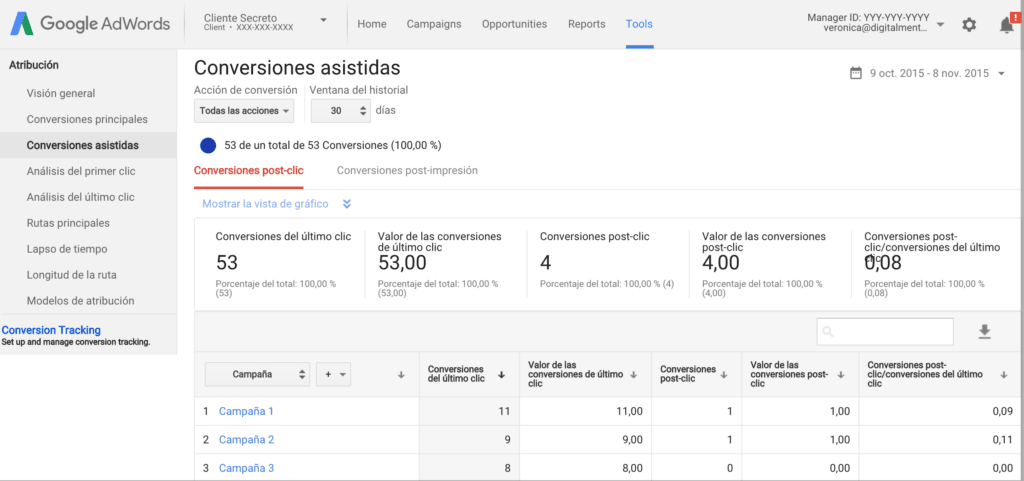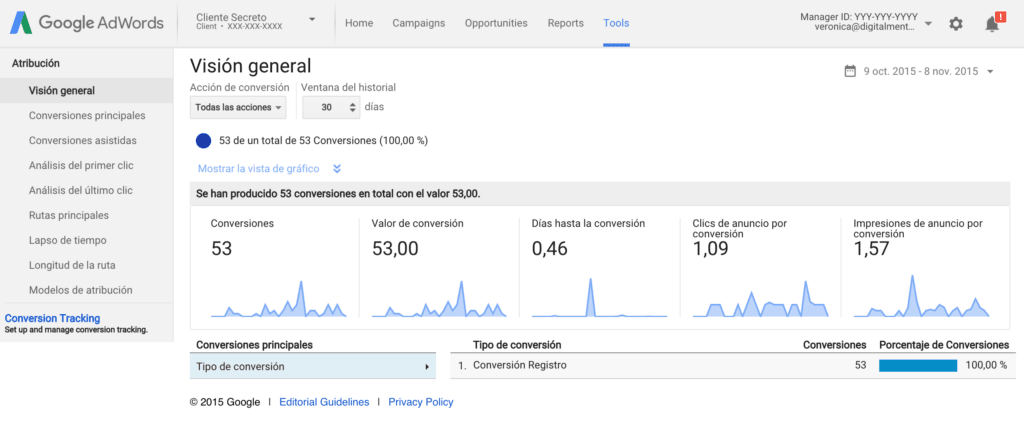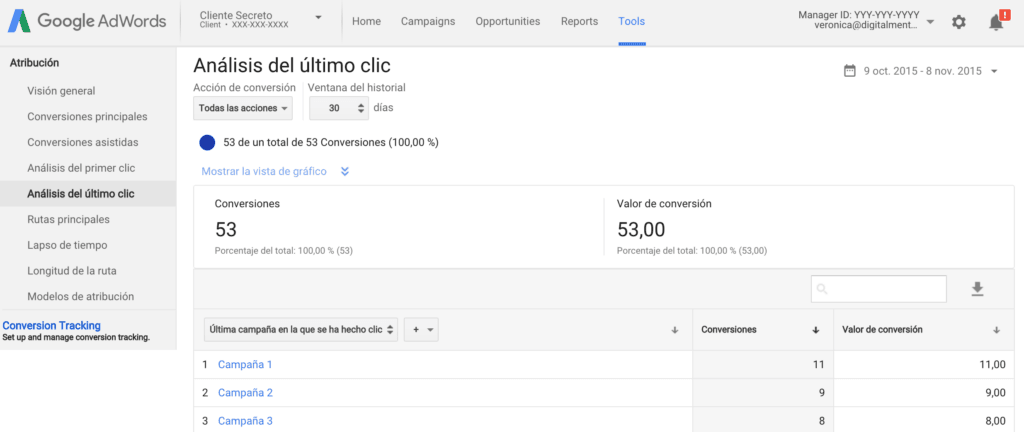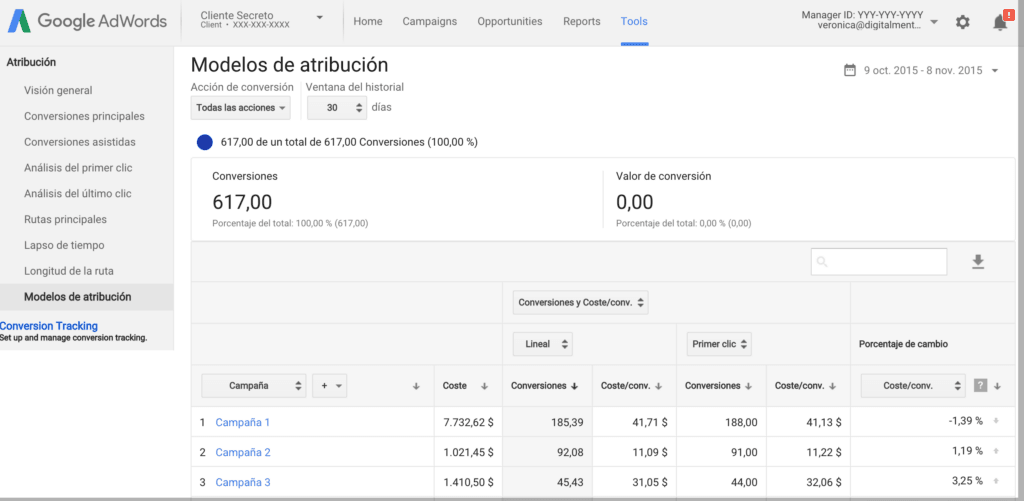Cómo funciona la Herramienta de Atribución en AdWords
¿Por qué mis conversiones en AdWords no coinciden con las que me muestra Analytics? Entender los modelos de atribución es fundamental para poder analizar los resultados correctamente y tomar las medidas oportunas. Cada herramienta o plataforma que utilizamos utiliza un modelo de atribución diferente y si no somos conscientes, podemos estar llevando a cabo un análisis desvirtuado que nos conduce a errores.
¿Qué pasa cuando un usuario hace clic en un anuncio de AdWords y después en uno de Facebook antes de convertir? ¿Quién “se lleva” la conversión?
Estas preguntas tienen su respuesta en el propio modelo de atribución en AdWords o Facebook, o en el de Analytics si nos basamos en esta herramienta para analizar las métricas.
Hoy vamos a ver cómo funciona el modelo de atribución en AdWords. Dejaremos para otro post el modelo de atribución en Facebook y todos los que hay disponibles en Analytics, tendrás que leerlos todos para entender cómo analizar los datos correctamente y convertirte en un verdadero SEM Manager 😉
Estudio de la atribución en AdWords
Dentro de AdWords podemos analizar cómo las campañas, grupos de anuncios o keywords contribuyen a que otras campañas, grupos de anuncios y keywords de la cuenta conviertan. Además veremos cuánto dura la ruta hacia la conversión y cuántas interacciones con las campañas se producen hasta cumplir el objetivo.
Para ver todo esto navegaremos por el menú principal hasta acceder a “Herramientas” y seleccionar “Atribución”:
Aquí encontramos una visión general de las acciones de conversión, su valor -si se le ha asignado-, el tiempo que pasa hasta que el usuario convierte y los clics e impresiones que se producen de media antes de convertir.
Naveguemos ahora por el menú de la izquierda:
Conversiones principales
Despliega el menú de ventana del historial para ver la diferencia en el número de conversiones según la ventana que hayas escogido.
Conversiones asistidas
En esta pantalla podemos ver cómo campañas, grupos de anuncios, keywords o incluso “tipos de concordancia” ayudaron a convertir a otras campañas, grupos de anuncios, keywords o “tipos de concordancia”.

Análisis de las asistencias de palabras clave, grupos de anuncio o campañas al total de conversiones
En este caso, la campaña 1 y la campaña 2 contribuyeron a que otra campaña tuviera una conversión respectivamente. Es decir, el usuario hizo clic en la campaña 1 y terminó convirtiendo tras hacer clic en otra campaña distinta de 1. Y lo mismo con la campaña 2.
El último indicador, conversiones post-clic/conversiones del último clic es un indicador a función de una campaña, grupo de anuncios, keyword o tipo de concordancia en la ruta hacia la conversión. Más próximo a cero indicaría que cerró más conversiones de las que ayudó a cerrar. Si es mayor que 1 indicaría que el elemento analizado está ayudando a cerrar conversiones más que completando conversiones por sí solo.
Este informe es muy valioso, porque nos permite distinguir keywords y campañas que aunque parecen no tener resultados contribuyen de forma significativa al total de conversiones. Generalmente nos encontramos aquí con las campañas genéricas, que sirven para captar al usuario y más tarde el usuario convertirá cuando realice una búsqueda más específica.
Análisis del primer clic – Análisis del último clic
Muestra los datos de conversiones según la campaña, grupo de anuncios, keyword o tipo de concordancia en que el usuario ha hecho clic por primera vez o por última vez antes de convertir.
Rutas principales
Enseña los caminos más frecuentes hacia la conversión. En el desplegable podemos elegir a qué nivel queremos verlo: campaña, grupo de anuncios, keyword.
Lapso de tiempo
Esta pantalla es muy interesante para corroborar que la ventana de conversión que aplicamos en nuestras campañas es la idónea. Nos dice el tiempo que pasa desde que se hace clic en algún anuncio hasta que ocurre la conversión.
Longitud de la ruta
Cuántos clics ocurren hasta que el usuario convierte. Te ayudará a saber si tu producto/servicio requiere muchas interacciones con las campañas hasta la conversión: comparación de precios, estudio de características, etc.
Modelos de atribución
Este informe muestra una comparativa de los modelos de atribución en AdWords, es decir, entre nuestras propias campañas. Veremos también cómo la utilización de un modelo u otro influye en nuestro coste/conversión o registro de conversiones (porcentaje de cambio):
- Último clic: asigna la conversión a la última palabra clave en la que el usuario hace clic antes de convertir.
- Primer clic: asigna la conversión a la primera palabra clave en la que el usuario hace clic.
- Lineal: asigna la conversión de manera uniforme entre los clics de la ruta hacia la conversión.
- Depreciación temporal: tendrán más peso los clics que estén más cercanos a la conversión.
- Según la posición: el primer y el último clic obtienen el 40% del mérito de la conversión. El otro 20% se reparte de manera uniforme entre los clics de la ruta.
El modelo de atribución de AdWords como canal
El modelo de atribución que AdWords utiliza por defecto como canal es conocido como “Último clic de AdWords”, es decir, AdWords registrará una conversión siempre que el usuario que convierte haya hecho clic en algún anuncio dentro de la ventana de conversión especificada.
No importa lo que pase después, el usuario puede hacer clic en un anuncio y no convertir ese día. Puede ver un anuncio en Facebook al día siguiente, hacer clic y convertir. En este caso AdWords seguirá registrando una conversión, porque en la ruta hacia la conversión de ese usuario se hizo clic en uno de sus anuncios. Tendremos 2 conversiones en nuestros datos (1 de AdWords y 1 de Facebook) pero realmente sólo se habrá producido 1 conversión.
Esta es la problemática habitual cuando el anunciante utiliza más de una plataforma de advertising: Facebook, AdWords, Twitter… si intervienen 2 o más canales en la ruta hacia la conversión ¿a cuál se le asigna?
La solución más sencilla que tenemos a nuestra mano es Google Analytics. El modelo de medición de Analytics es “Último clic indirecto”, lo que quiere decir que Analytics asigna la conversión al último canal en el que el usuario haya hecho clic antes de convertir, siempre que no sea tráfico directo. Por tanto, otorga una visión más realista de las aportaciones de cada canal en lo que a conversión se refiere. Como este tema requiere una mayor profundidad, analizaremos esta problemática y sus soluciones en nuestro próximo post ¿nos acompañas?






